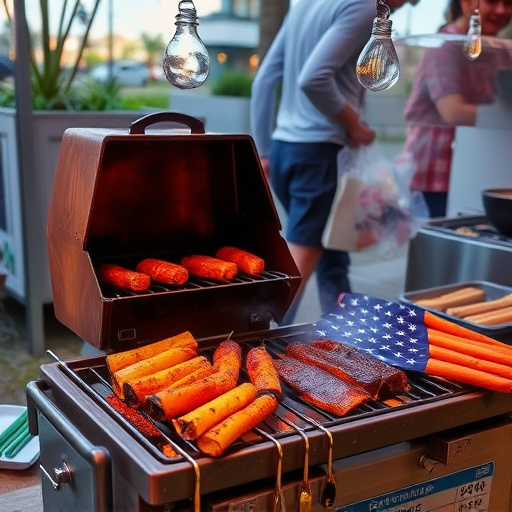Choosing the right cut (baby back, spare rib, St. Louis style), seasoning with marinades and rubs, using direct vs indirect heat, low & slow smoking (225°F-250°F for 4-6 hours), foil technique, glazing with sauces or toppings, and resting ribs for 10-15 minutes after cooking, are key steps to create a perfect BBQ spare ribs recipe. Present them cut into pieces with fresh herbs and sauce options for a memorable dining experience.
“Unleash your inner BBQ master with our comprehensive guide to grilling perfectly cooked spare ribs. From understanding cut types and their impact to mastering direct heat vs. indirect cooking, this article covers it all. Learn about effective seasoning techniques using marinades and rubs, and discover the art of smoking for tender, juicy results. We’ll walk you through the foil technique, optimal cooking times, and finishing touches with glazes. Plus, get expert tips on resting, cutting, and serving your mouthwatering BBQ spare ribs recipe.”
- Understanding Spare Ribs: Cut Types and Their Impact
- The Right Seasoning: Marinades and Rubs for Flavorful Ribs
- Master the Grill: Direct Heat vs Indirect Cooking for Ribs
- Low and Slow: Smoking Techniques for Tender, Juicy Ribs
- Handling the Wrap: Foil Technique and Cooking Times
- Glazing for Shine: Sauces and Toppings to Seal in Juiciness
- Resting is Crucial: Letting Your Ribs Settle After Cooking
- Cutting and Serving Tips: Presenting Your Perfect Ribs
Understanding Spare Ribs: Cut Types and Their Impact
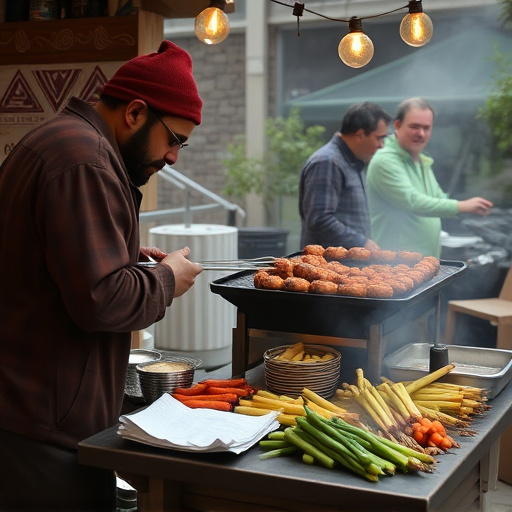
Spare ribs, a classic BBQ favorite, come in various cuts, each with its unique characteristics and cooking properties. When it comes to grilling perfect BBQ spare ribs, understanding these different cuts is key. The most common types include baby back, spare rib, and St. Louis style. Baby backs have less bone and fat, making them tender and popular for quick grill sessions. Spare ribs, with more meat attached to the bone, require slower cooking to achieve a melt-in-your-mouth texture. St. Louis-style ribs, also known as “cut in between,” are essentially spare ribs cut into individual segments, allowing for quicker grilling while still retaining flavor.
The cut of your spare ribs significantly influences cooking time and technique. For instance, baby backs tend to cook faster due to their leaner composition, while St. Louis-style ribs benefit from a longer, indirect heat approach to ensure the meat stays moist and the bone sticks firmly. Choosing the right cut for your BBQ spare ribs recipe can make all the difference in achieving that coveted, tender, and juicy finish.
The Right Seasoning: Marinades and Rubs for Flavorful Ribs
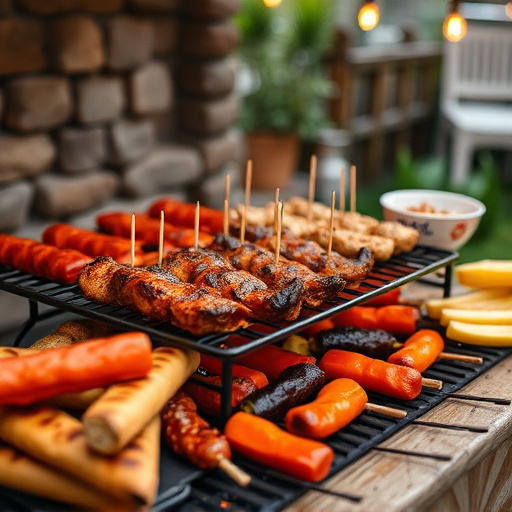
The key to mouthwatering BBQ spare ribs starts with the right seasoning. A good marinade or rub is essential for infusing ribs with flavor and tenderizing them during the cooking process. Marinades, soaked in for several hours or overnight, offer a moist and mild flavor profile by combining oils, acids, spices, and herbs. Popular choices include a basic combination of ketchup, brown sugar, vinegar, garlic, and paprika. Rubs, on the other hand, are dry seasonings applied directly to the rib meat, creating a complex, savory crust. Ingredients like salt, pepper, chili powder, cumin, and dried herbs deliver a robust flavor that clings to the ribs as they cook.
For a truly exceptional BBQ spare ribs recipe, experiment with different rubs and marinades to find your perfect combination. Remember, the right seasoning not only enhances taste but also plays a crucial role in achieving that coveted caramelized, slightly crunchy exterior while keeping the meat tender and juicy on the inside.
Master the Grill: Direct Heat vs Indirect Cooking for Ribs
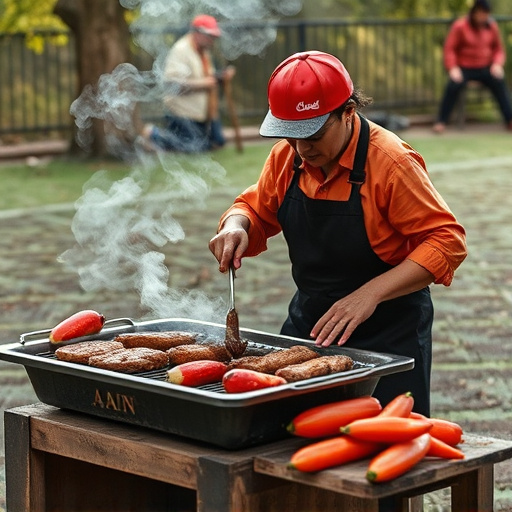
When it comes to grilling perfect BBQ spare ribs, understanding the art of direct heat versus indirect cooking is key. Direct heat grilling, characterized by high, intense flames, works wonders for searing the exterior of your ribs, locking in that mouthwatering smoky flavor. This method is ideal for shorter cooking times and achieving a crispy, caramelized crust. However, for tender, fall-off-the-bone ribs, indirect cooking is the champion. This involves cooking your ribs slowly over lower heat, away from direct flame, allowing them to cook evenly and thoroughly. It’s a patient process but results in ribs that are incredibly juicy and tender.
For a mouthwatering BBQ spare ribs recipe, many experts recommend using a combination of both techniques. Start by searing the ribs over high heat for a few minutes on each side to develop that desirable crust, then finish them slowly over indirect heat until they reach the desired tenderness. This two-step approach ensures your ribs are perfectly cooked, boasting that classic smoky BBQ flavor and an ideal texture that satisfies every time.
Low and Slow: Smoking Techniques for Tender, Juicy Ribs
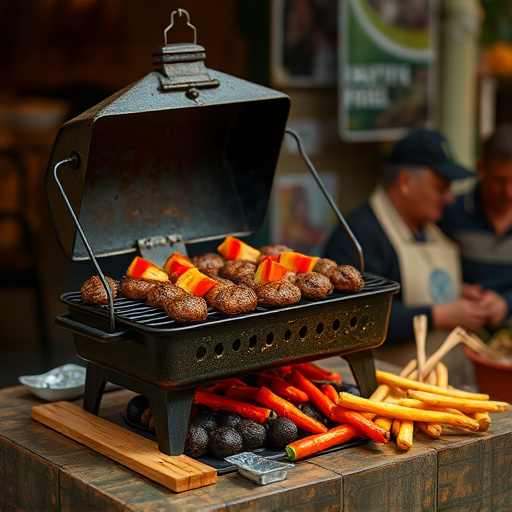
For perfectly cooked BBQ spare ribs, embrace the power of low and slow smoking techniques. This method ensures that your ribs develop deep, rich flavors while remaining tender and juicy. Start by preheating your smoker to a consistent temperature between 225°F and 250°F (107°C to 121°C). This slow cooking process breaks down the collagen in the meat, transforming it into gelatin, which keeps your ribs moist and tender.
Apply a generous layer of your favorite BBQ rub all over the ribs before placing them on the smoker. This seasoning blend adds not only flavor but also helps to create a crispy, golden-brown crust as the spare ribs cook slowly. Maintain a steady low heat, allowing the smoke to gently permeate the meat for several hours until they reach an internal temperature of around 195°F (90°C). Patience is key; it may take 4-6 hours or more, but the result will be spare ribs that simply fall off the bone.
Handling the Wrap: Foil Technique and Cooking Times
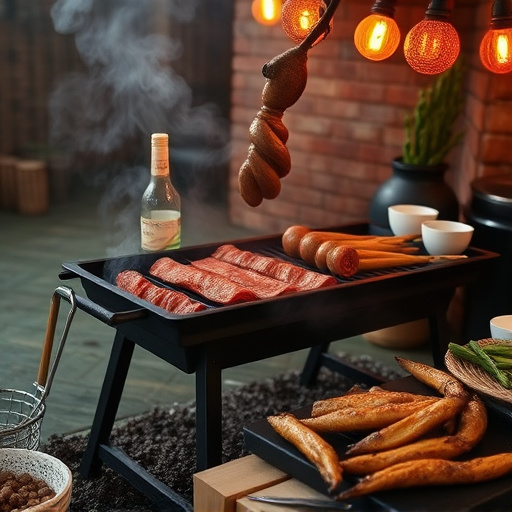
When it comes to grilling perfectly cooked BBQ spare ribs, the foil technique is a game-changer. This simple method ensures even heat distribution and locks in that mouthwatering moisture. Start by wrapping your ribs tightly in aluminum foil, sealing it well at the edges. The foil acts as an insulator, keeping the heat in and preventing overcooking.
Cooking times vary depending on your grill’s temperature and rib thickness. As a general guideline, aim for around 2-3 hours indirect heat. For that classic BBQ flavor, finish with a direct heat sear for about 10-15 minutes per side. This step not only adds that delightful charred exterior but also helps to caramelize the natural sugars, making your spare ribs the star of any BBQ spread.
Glazing for Shine: Sauces and Toppings to Seal in Juiciness
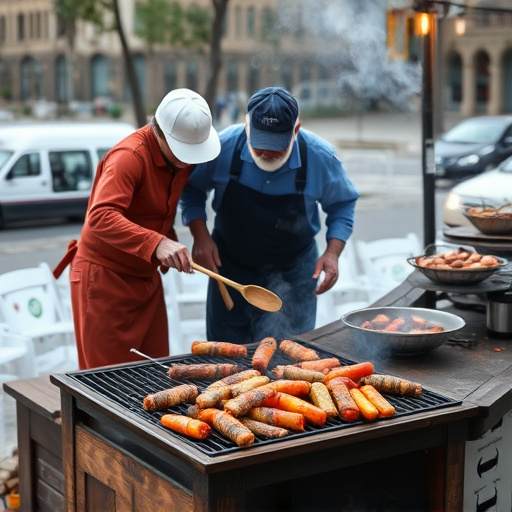
To achieve that glossy, mouthwatering finish on your BBQ spare ribs recipe, glazing is a crucial step. After grilling for an initial sear and slow cooking to tenderize the meat, applying a glaze acts as a barrier against further moisture loss, sealing in all those delicious juices. Think of it as an extra layer of protection for your ribs, enhancing their flavor profile and ensuring each bite is juicy and mouth-watering.
Choosing the right glaze can elevate your BBQ spare ribs recipe to new heights. Opt for a sweet and tangy ketchup-based glaze or go for a more savory blend of BBQ sauce and Worcestershire. You could even experiment with unique toppings like honey, brown sugar, or chili paste for an extra kick. Whatever you choose, make sure it’s well-coated on both sides of the ribs to achieve that glossy shine and tantalizing taste that will have folks licking their bones clean at your next BBQ gathering.
Resting is Crucial: Letting Your Ribs Settle After Cooking

After grilling your BBQ spare ribs recipe to perfection, resting is a critical step often overlooked. Once cooked, remove your ribs from the grill and let them sit for about 10-15 minutes before slicing or serving. This resting period allows the juices to redistribute throughout the meat, ensuring every bite is tender and flavorful. During this time, the internal temperature of the ribs will continue to rise slightly, securing that delicious juiciness inside.
Proper rest time enables your spare ribs to achieve a level of doneness that can’t be rushed. It’s during this settling period that the collagen in the meat breaks down, resulting in those lip-smacking, fall-off-the-bone ribs you’re aiming for. So, resist the urge to serve them immediately; let your ribs rest and revel in the fact that you’ve just cooked up a true BBQ masterpiece.
Cutting and Serving Tips: Presenting Your Perfect Ribs

When it comes to serving your perfectly grilled BBQ spare ribs, presentation is key to impressing your guests. Start by cutting the ribs into individual portions, ensuring each piece has a good balance of meat and bone. A sharp knife or a pair of kitchen shears will make this task easier. You can choose to cut them in between the bones for shorter pieces or leave them in larger chunks for a more substantial bite.
For an appealing plate, arrange the ribs in a visually attractive manner. Consider adding some fresh herbs like rosemary or thyme as a garnish, and don’t be afraid to include a variety of sauces on the side—from classic BBQ to a tangy apple cider vinegar-based sauce. This not only caters to different tastes but also allows your guests to customize their ribs according to their preferences.
